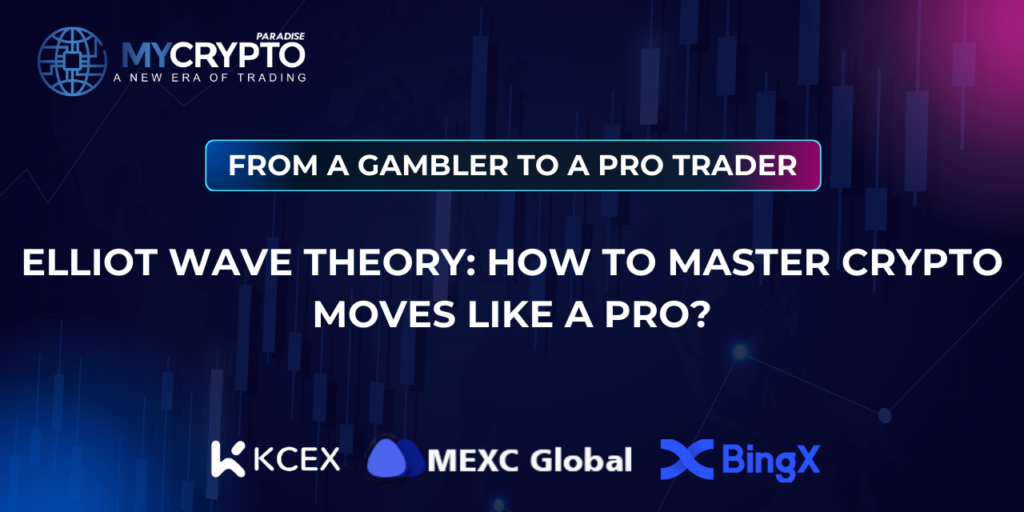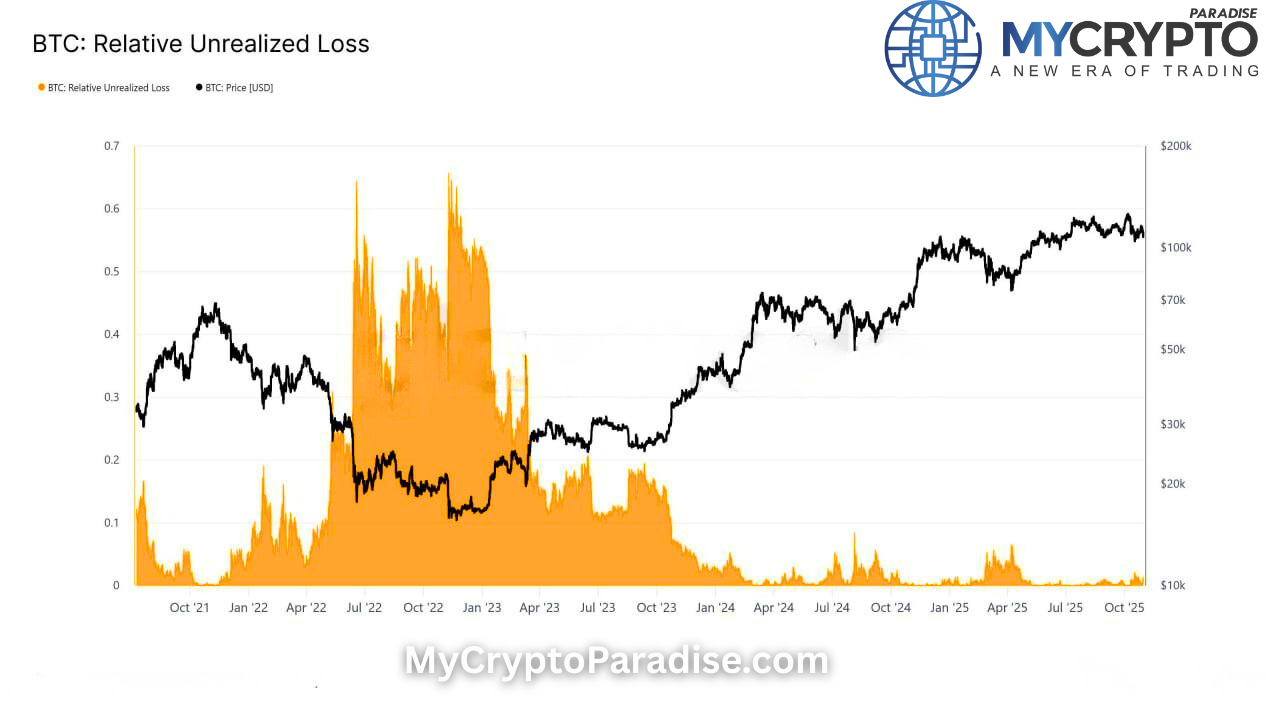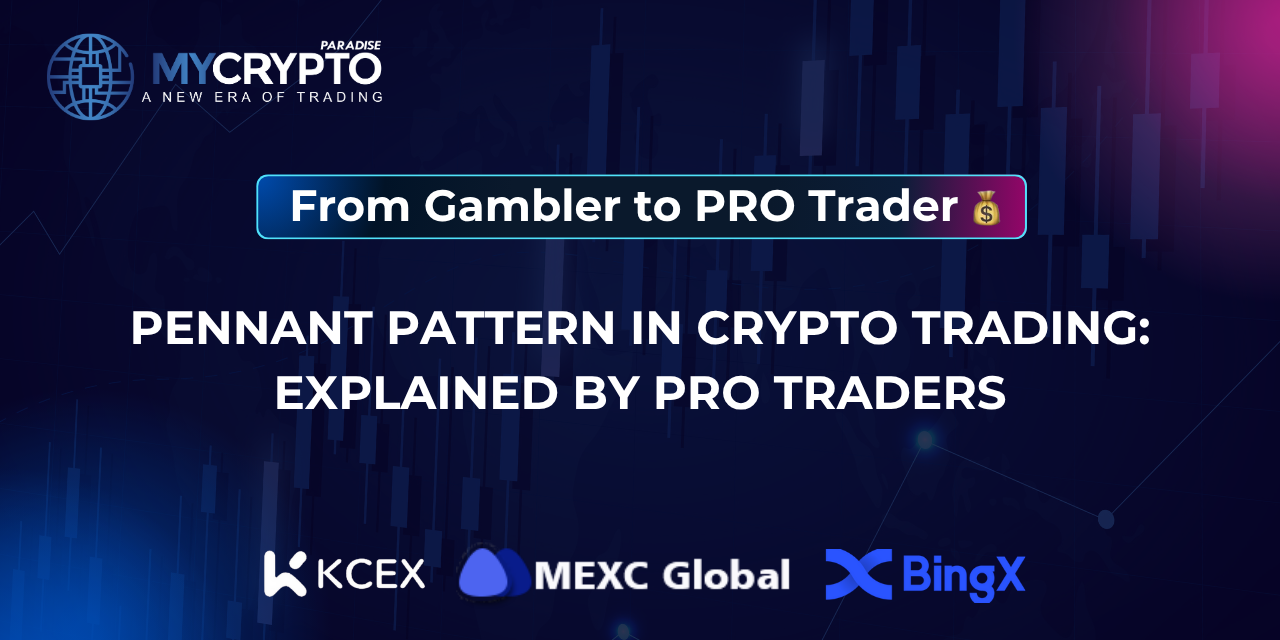Why does the crypto market suddenly change direction, even when everything seems to be moving in your favor? That’s where the power of Elliot Wave Theory comes in to help you understand. It reveals hidden patterns in the market, often unnoticed by most crypto traders, that signal when momentum is about to shift. These wave patterns act like a roadmap to help professional traders identify when trends will reverse or continue.
Similar to ParadiseFamilyVIP 🎖️, serious traders who master Elliot Wave Theory can strategically anticipate market moves and gain an edge in crypto trading. At its core, this approach provides a secure framework for managing capital and ensuring safe trading decisions. We will dive into the Elliot Wave Theory and see how these can help you trade like a PRO.
Let’s break down the crypto market waves:
Introducing Elliot Wave Theory
Elliot Wave Theory is a powerful tool professional traders use to predict crypto market movements. The theory developed by Ralph Nelson Elliott in the 1930s is based on the idea that financial markets move in natural, repeating cycles, driven by collective trader psychology. These cycles are divided into wave patterns, which can help crypto traders anticipate market direction accurately.

By understanding these wave patterns, traders can strategically plan their trades to protect their investments and improve their overall money management. The beauty of Elliot Wave Theory is that it applies across all markets and timeframes, making it a versatile tool for both short-term and long-term traders.
Let’s see why you must learn the wave theory:
Why Every Trader Should Understand Waves?
Understanding Elliot Waves is crucial if you’re serious about trading, especially in a fast-moving market like crypto. You can think of the market as a crowd of people moving together. Sometimes they’re excited and driving prices up, other times they’re cautious, causing prices to fall. Elliot Wave Theory helps you read these crowd behaviors and, more importantly, predict what might come next.
This is why traders who know how to apply Elliot Wave Theory often find themselves one step ahead. It’s not just about following the current trend; it’s about anticipating when it will change. And let’s face it—timing is everything in trading. Knowing when a wave is about to reverse can distinguish between a winning trade and a loss.
Elliot Wave Theory is still incredibly relevant today despite being created in the 1930s. In fact, it’s even more valuable in the modern financial markets, where emotions can swing wildly, especially in crypto. Traders who understand these wave patterns are better equipped to protect their capital and make smarter decisions.
The Origins of Elliott Wave Theory
Ralph Nelson Elliott wasn’t your typical economist or financial expert. In fact, his journey toward discovering one of the most influential theories in trading started a bit later in life. After years of working as an accountant and business executive, Elliott became deeply fascinated by the stock market. But unlike others, he wasn’t content with just watching prices go up and down—he wanted to know why.
In the 1930s, Elliott began studying decades of market data while recovering from illness. What he noticed was something remarkable: market movements weren’t as random as they seemed. He observed that markets followed distinct, repeating cycles that mirrored patterns found in nature. These weren’t just numbers on a chart; they reflected the ebb and flow of human psychology. Fear, greed, hope, and caution all played out in waves, and Elliott was able to connect these emotions to market behavior.
What are the Basic Principles of Wave Theory?
At the heart of Elliott Wave Theory is a simple yet powerful idea: markets move in waves. These waves aren’t chaotic; they’re part of a larger, predictable structure that repeats over time. Elliott identified two types of waves: impulse waves, which move in the direction of the trend, and corrective waves, which go against it. Together, they create the cycles that make up the larger market picture.
One of the most fascinating aspects of Elliott Wave Theory is its fractal nature. This means that similar wave patterns can be found, no matter how small or large, in the market movement. Just like fractals in nature, where the same pattern repeats itself in ever-smaller forms, market waves follow this same principle. Whether you’re looking at a five-minute chart or analyzing years of data, the wave structure remains consistent.
Understanding this principle allows traders to zoom in and out of the market with a strategic view, spotting opportunities in both minor and major moves. By recognizing where you are within a wave cycle, you can make more informed decisions, protect your investments, and ultimately trade more confidently.
As we have understood the basic principles behind the wave theory, let’s move on to understand the basic structure:
The Basic Structure: Impulsive and Corrective Waves
When you break down Elliot Wave Theory, it’s important to understand that the market moves in two main phases: impulsive waves and corrective waves. These are the building blocks of market movement, and mastering them will help you navigate trends like a PRO.
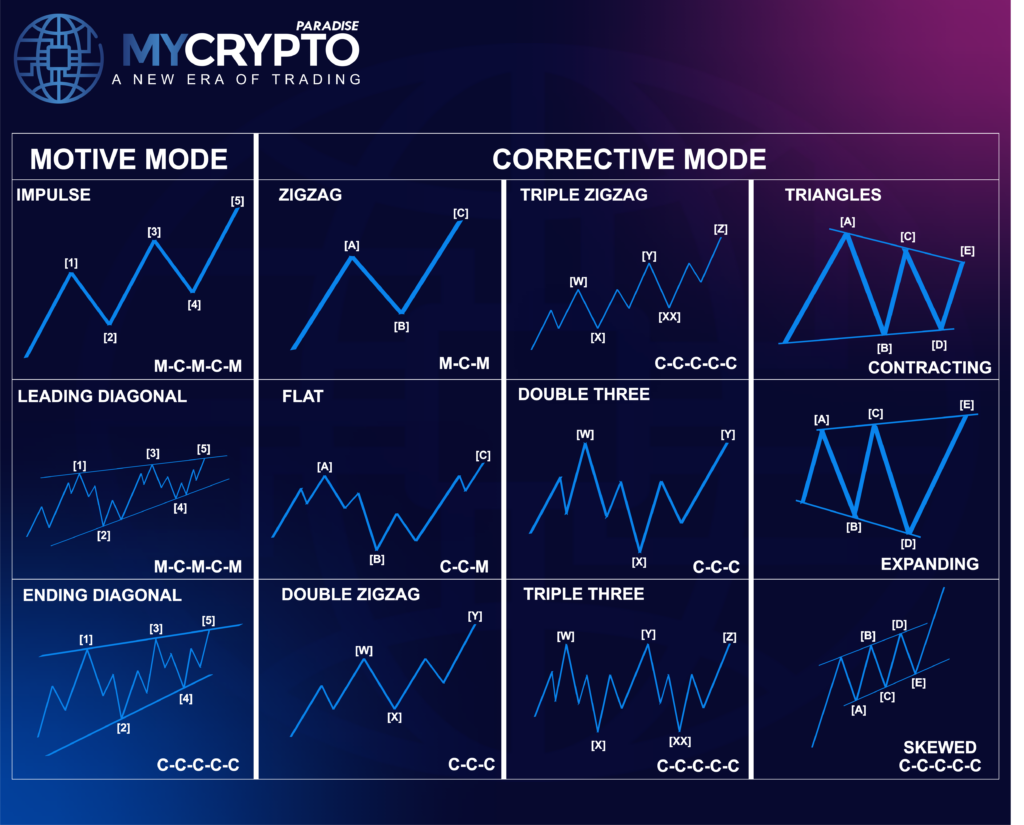
In Elliott Wave Theory, Impulse waves are the primary motive waves, while Leading Diagonal and Ending Diagonal are specialized variations that mark key stages in the trend—Leading Diagonals signal the start of a trend, and Ending Diagonals indicate its conclusion.
Impulsive Waves:
At the core of an impulsive wave is the idea of moving in the direction of the trend. When the market is trending, whether up or down, it typically follows a 5-wave structure. The first three waves push in the direction of the trend, known as motive waves, while the other two waves act as short-term pullbacks, called corrective waves. This 5-wave pattern is key to understanding how markets behave in a strong trend, and it’s a reliable tool for serious traders.
Here’s a quick breakdown of how these waves unfold:
- Wave 1: The initial push that sets the trend (bullish or bearish) in motion.
- Wave 2: A short correction that doesn’t retrace more than 100% of Wave 1.
- Wave 3: Typically the strongest wave—this one can’t be the shortest.
- Wave 4: A small pullback before the final push.
- Wave 5: The final burst of momentum before the trend is exhausted.
How Each Impulse Wave Typically Behaves
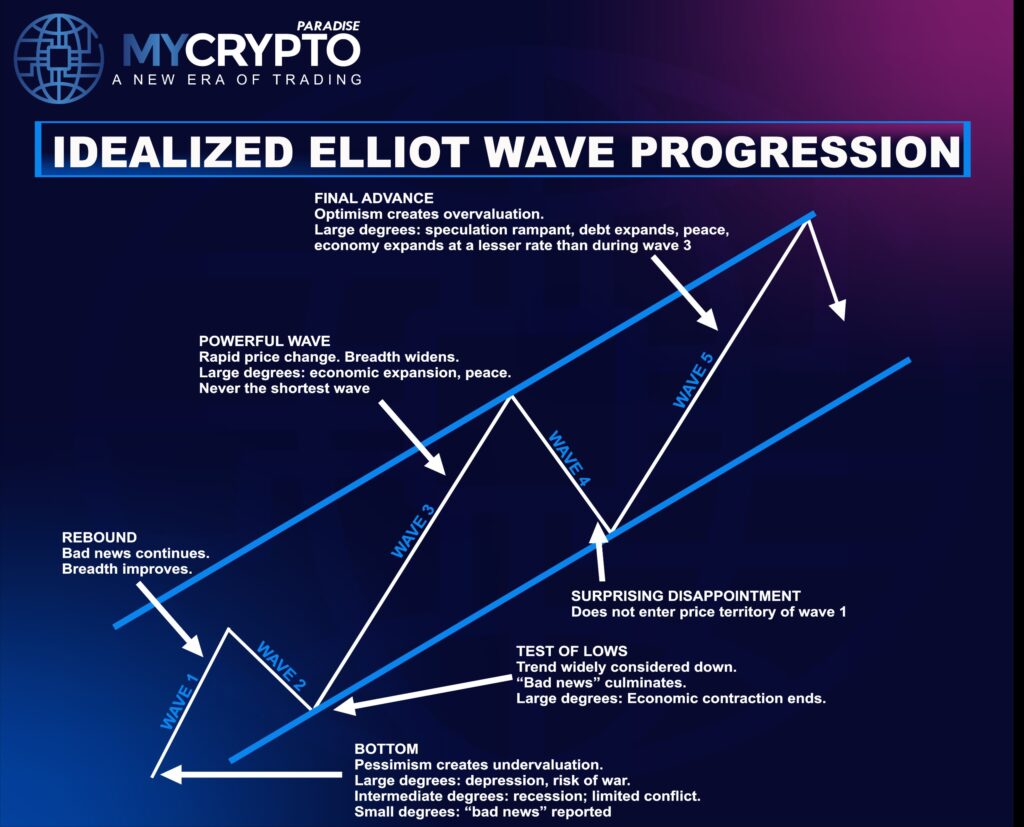
First Wave
About half of the first waves are part of a basing process and get heavily corrected by wave two. Unlike bear market rallies, they show subtle strength in volume and breadth. Short selling is common, as most still believe the trend is down. Many see it as “one more rally to sell on.
Second Wave
Second waves often retrace most of wave one, erasing gains. Investors become convinced the bear market is back. These waves usually end with low volume and volatility, signaling fading selling pressure.
Third Wave
The third of a third is typically the most explosive point, with breakouts, gaps, volume spikes, strong breadth, and big gains. The personality of the third wave helps identify wave counts in real time.
Fourth Wave
Fourth waves differ from second waves in form and depth, often moving sideways. They build the base for the final rise. Weaker areas tend to peak and decline here, showing early signs of weakness and setting up non-confirmations for the fifth wave.
Fifth Wave
Fifth waves are less dynamic than third waves, with slower movement and narrower breadth. Volume only increases if the wave extends, especially below the primary degree. Peaks do not come with maximum acceleration. Even extended fifth waves lack the strength of earlier moves.
If you want a deeper dive into the Impulsive Waves, you can Click Here.
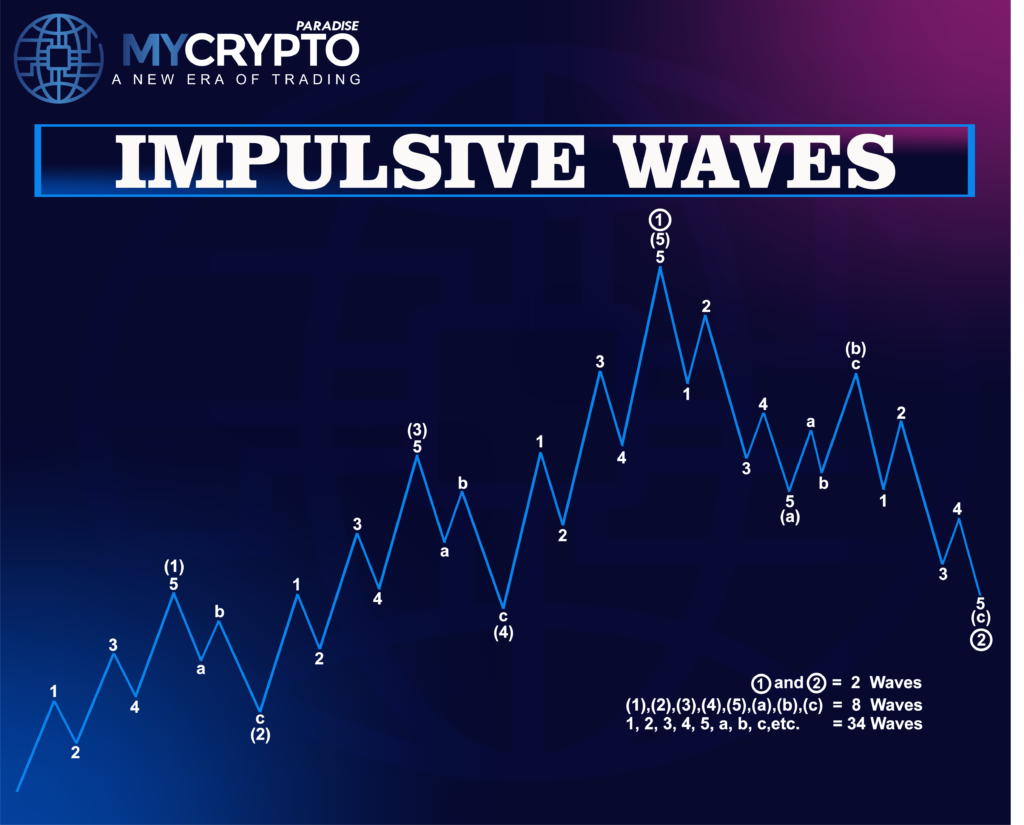
In bull markets, these waves move upward, while in bear markets, they push downward. The key is recognizing these wave patterns early, so you can ride the trend before it’s over.
A few rules to remember when spotting impulsive waves:
- Wave 2 can never retrace more than 100% of Wave 1, meaning it can’t dip below where the trend started.
- Wave 3 is usually the most powerful and can never be the shortest of the three motive waves.
- Wave 4 should never overlap with Wave 1, keeping the trend structure intact.
Knowing these rules helps crypto traders stay safe by protecting their trades from false signals and making informed decisions about when to enter or exit.
Corrective Waves:
After every impulse comes a correction, and this is where many traders get tripped up. Corrective waves are counter-trend moves that come in a 3-wave structure, labeled A-B-C. These pullbacks can feel tricky because they often lead traders to believe the trend is over when, in fact, the market is just taking a breather.
How Each Corrective Wave Typically Behaves
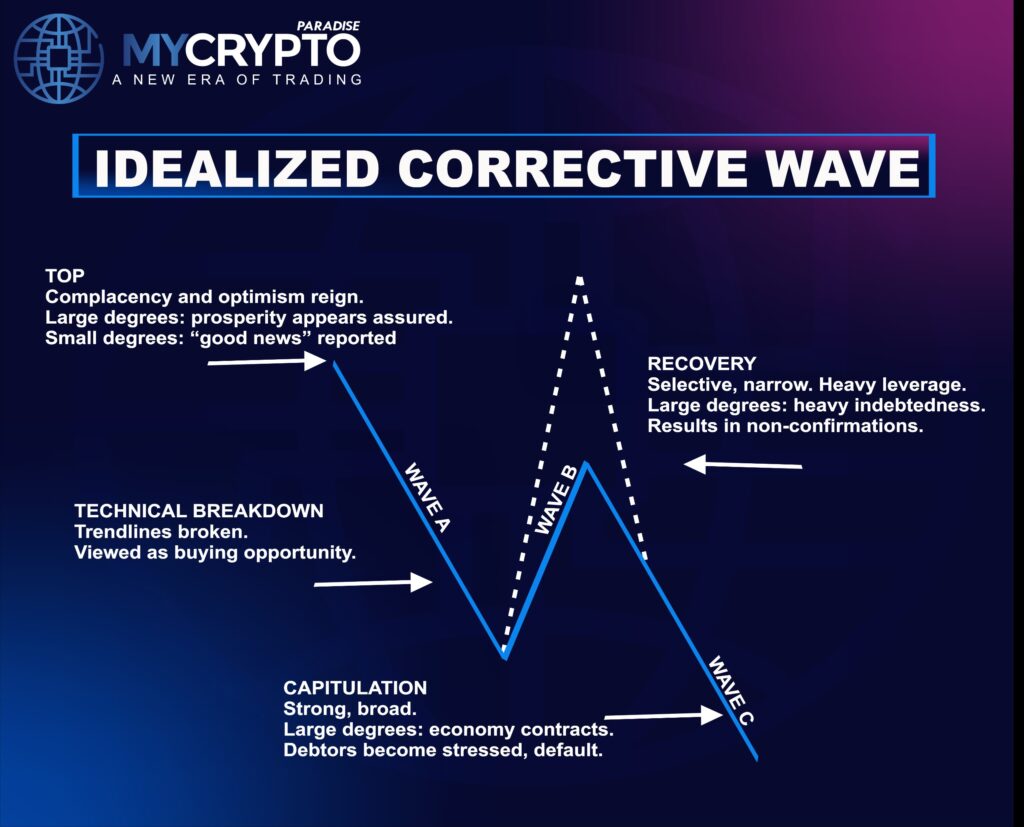
A Wave
In a bear market, the A wave is seen as a temporary pullback before the next advance. Many continue buying, even as technical damage begins to show. The structure of A influences B: a five-wave A implies a zigzag B, while a three-wave A points to a flat or triangle.
B Wave
B waves are deceptive bull traps, speculative, narrow, and often technically weak. They tend to concentrate in select areas and lack confirmation from the broader movement. These rallies are almost always fully retraced by wave C. X and D waves in expanding triangles share similar traits. If something feels “off” in the market, it’s likely a B wave.
C Wave
C waves are strong and broad. The economy contracts, and stress builds. Debtors face pressure and may default. This wave follows the failed recovery of wave B and completes the correction
Corrective patterns come in several forms, but the three most common are:
Zigzag:
The Zigzag pattern is perhaps the most straightforward corrective structure, but it can also be deceptive. It’s a sharp, straight-line correction, where prices fall quickly, creating the illusion that the trend has reversed. In a Zigzag, Wave A typically has a strong momentum counter to the main trend, followed by a shallow Wave B that doesn’t retrace much of Wave A, and finally, a steep Wave C that often extends beyond the low of Wave A.
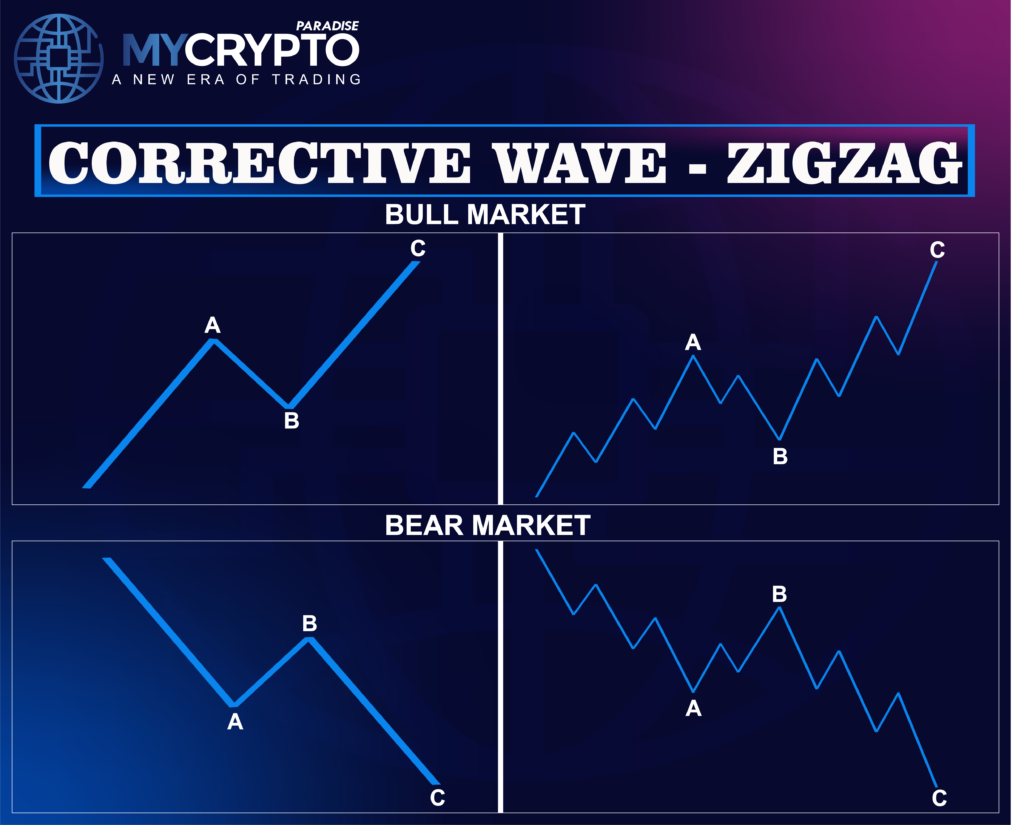
Characteristics of a Zigzag:
- Usually steeper and more pronounced than other corrections.
- It can give the impression of a major trend reversal due to its sharp nature.
- It often retraces between 38.2% to 61.8% of the previous impulsive wave.
Curious to explore the Zigzag pattern in detail? Click here to learn more.
For traders, Zigzags can be tricky because they happen fast and may cause you to believe the trend has reversed completely. However, recognizing the pattern early allows you to stay disciplined, avoid panic, and prepare for the trend’s continuation once the correction is over.
Flat:
The Flat corrective pattern is less dramatic than the Zigzag and often leads to frustration because the market doesn’t seem to make much headway. Flats are sideways corrections where all three waves (A, B, and C) are of relatively equal length, and Wave B often retraces close to or beyond the starting point of Wave A. Want to dive deeper into how Flat correction works? Click here for a full breakdown.
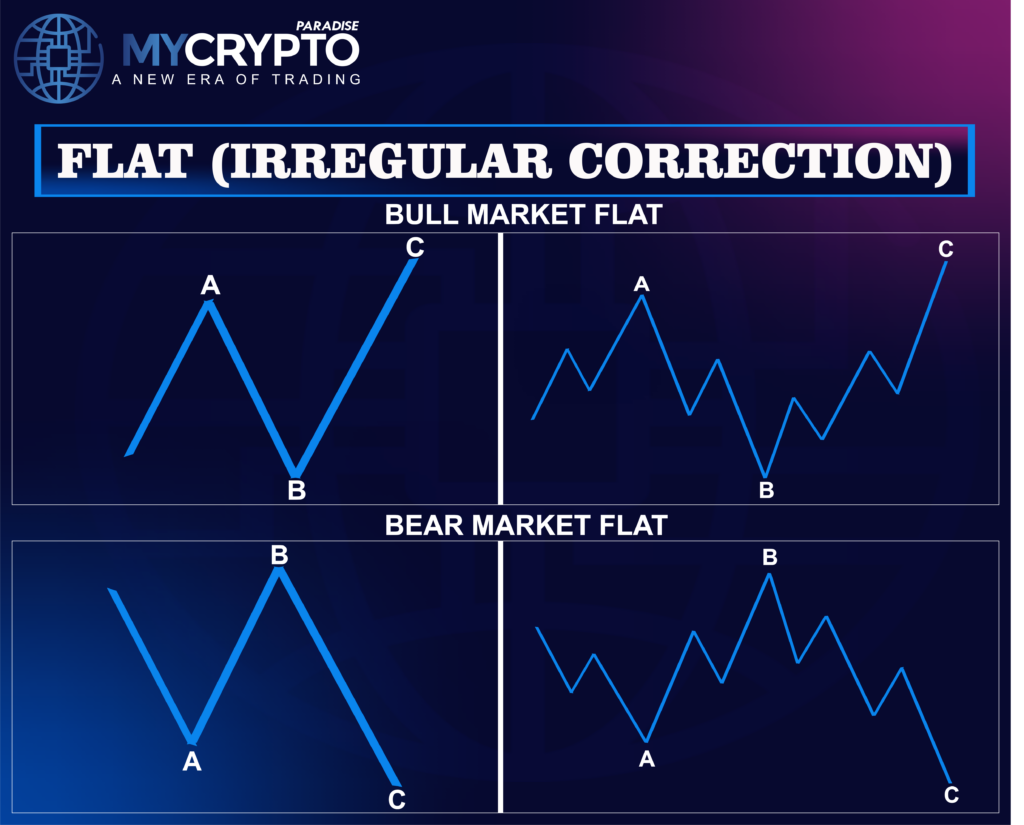
Want to dive deeper into how Flat correction works? Click here for a full breakdown. Now let’s see the characteristics of a Flat:
- Wave B tends to retrace close to 100% of Wave A.
- Wave C is usually shorter than Wave A and doesn’t extend far beyond it.
- The pattern is more horizontal, leading to limited price movement.
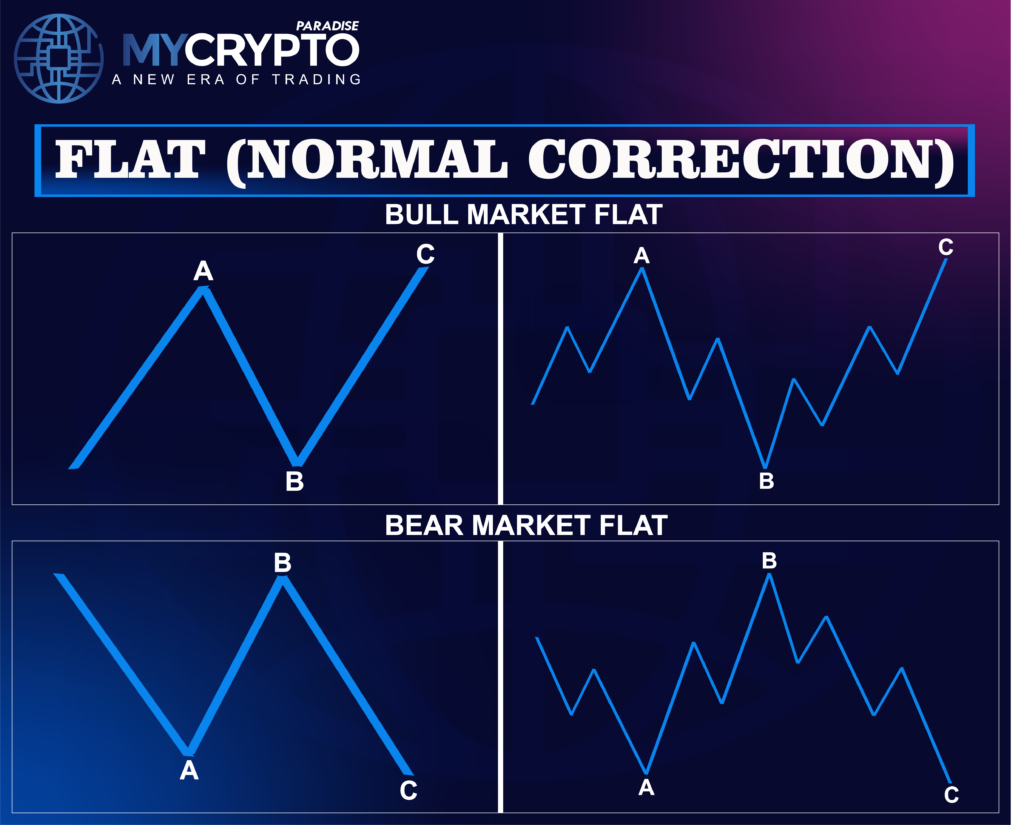
Flats can lull traders into thinking that the market is stuck or not going anywhere, but they are simply pauses in the overall trend. During a Flat, it’s crucial to practice patience and emotional discipline, waiting for the correction to complete before re-entering the market
Triangle:
The Triangle pattern is a consolidation phase where the market is essentially “recharging” for the next big move. Triangles form when price action narrows, creating a series of lower highs and higher lows (contracting triangle), or other variations like ascending or descending triangles. These patterns usually indicate that the market is undecided but building energy for a breakout in the direction of the larger trend.
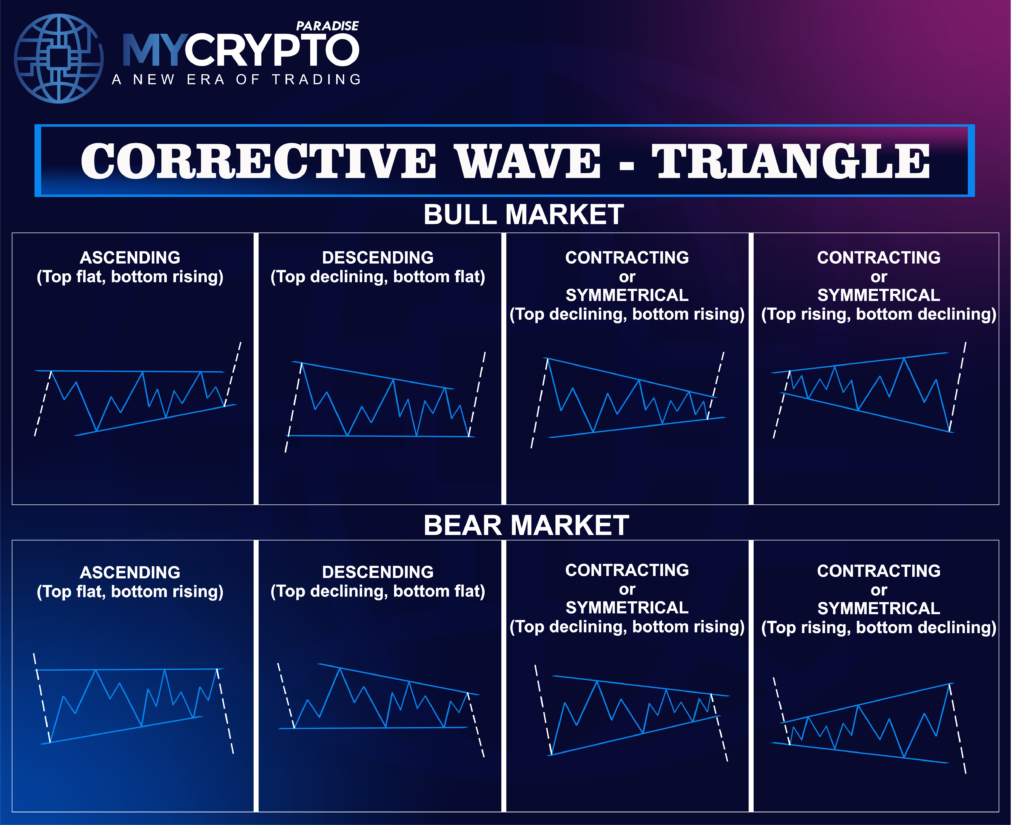
Characteristics of a Triangle:
- It consists of five smaller sub-waves labeled A-B-C-D-E.
- It can take on different shapes: contracting, expanding, ascending, or descending.
- Signals that the market is preparing for a strong move, typically in the direction of the preceding trend.
Triangles often form in the later stages of corrective waves, typically in Wave 4 of an impulsive structure. For traders, triangles are a signal that the market is consolidating, and a breakout is imminent. By correctly identifying a triangle, you can position yourself to ride the next wave with confidence, knowing that the market is building momentum for a fresh move.
Without a full understanding of these corrective waves, many traders misinterpret them as trend reversals. However, by recognizing these patterns, you can strategically position yourself to capitalize on the next big move while staying safe from false signals.
As we are done with the basic structure of Elliot Wave Theory, let’s understand wave degrees and fractals:
Introducing Wave Degrees and Fractals
Let’s break down the concept of wave degree and fractals:
The Concept of Degrees
One of the most fascinating aspects of Elliott Wave Theory is its ability to operate on multiple levels, or what we call wave degrees. Essentially, market waves don’t exist in isolation—they’re part of a larger, interlocking structure. You can think of it like Russian nesting dolls: each wave is part of a bigger wave, which is part of an even larger wave, and so on. These different levels of market movement are referred to as degrees, and they range from the smallest micro-movements to grand, multi-decade cycles.
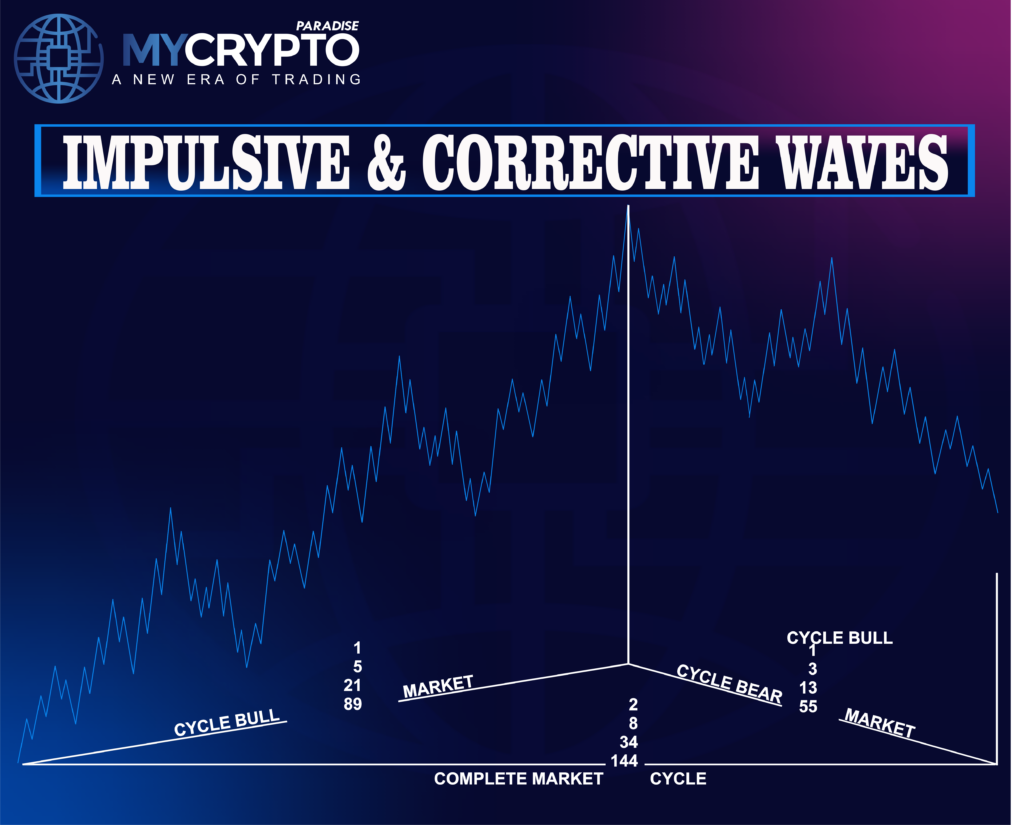
The major wave degrees include:
- Grand Supercycle: This is the largest wave, spanning centuries and often representing massive historical market changes.
- Supercycle: A step down from the Grand Supercycle, this wave typically lasts for decades and represents major trends.
- Cycle: This degree spans several years, typically seen in major bull or bear markets.
- Primary, Intermediate, Minor, Minute, Minuette, and Sub-Minuette: These smaller degrees represent shorter-term waves, from several months all the way down to hourly or even minute-by-minute moves in the market.
Each degree builds on the next to allow traders to zoom in and out of market trends depending on their strategy. By recognizing which wave degree you’re trading within, you can better anticipate the bigger picture and align your crypto trades accordingly, whether you’re focusing on short-term gains or long-term investments.
Fractals in Nature and Markets
One of the most striking aspects of Elliott Wave Theory is its fractal nature, meaning that the same patterns repeat on every level, no matter how big or small. This idea isn’t just limited to financial markets—it’s something we see everywhere in the natural world. You can think of how a tree’s branches mirror the structure of the entire tree or how a coastline, when viewed up close, has the same jagged pattern as seen from far away.
Similarly, Elliott Waves repeat themselves within the larger market cycle. For example, a Grand Supercycle wave may take decades to unfold, but within that massive movement, there are Supercycles, Cycles, and all the smaller degrees forming the larger trend. Each wave—whether big or small—follows the same basic impulse and corrective pattern, making the market movements predictable on multiple levels.
Let’s move further to see what the connection between Elliot waves and Fibonacci is:
What’s the Connection Between Fibonacci Ratios and Elliott Waves?
One of the key elements that makes Elliott Wave Theory so powerful is its connection to Fibonacci ratios, particularly the golden ratio, 0.618. This ratio, also known as Phi, appears not only in nature, from the spirals of seashells to the arrangement of leaves, but also in financial markets. Ralph Nelson Elliott discovered that market waves tend to follow these same mathematical relationships, which is why Fibonacci ratios play such a crucial role in Elliott Wave Theory.
In essence, Fibonacci ratios help us measure the proportion of one wave relative to another. For instance, after a strong impulsive move, corrective waves often retrace a predictable percentage of the previous wave, usually around 38.2%, 50%, or 61.8%.
Likewise, extensions beyond a certain point can also be anticipated, commonly showing up at 161.8% or even 261.8% of the prior wave. These ratios provide traders with a structured, mathematical way to predict potential turning points in the market.
How Can You Use Fibonacci Tools with Elliott Waves?
So, how do you apply Fibonacci ratios in your trading? That’s where Fibonacci retracement and extension tools come into play. These tools help you identify likely areas of support and resistance during a wave cycle, making it easier to pinpoint potential reversal points.
Here’s a practical guide to using Fibonacci tools with Elliott Waves:
Fibonacci Retracements:
After an impulsive wave (the strong, trending move), the market typically pulls back to correct. To predict where this pullback might stop, you can apply the Fibonacci retracement tool from the start of the impulsive wave to its peak (or vice versa in a downtrend). Common retracement levels are 38.2%, 50%, and 61.8%.
These levels often act as support in an uptrend or resistance in a downtrend. For example, if you see a market pulling back to the 61.8% retracement level after a strong upward move, it could be a signal that the market is ready to resume its trend.
Fibonacci Extensions:
When the market continues in the direction of the trend, Fibonacci extensions help you anticipate how far the price may extend. By measuring the distance of the previous impulsive wave and applying these ratios, such as 161.8%, you can predict where the next price targets may be. This is especially useful when you’re riding an impulsive wave and need to know when it might run out of steam.
For instance, let’s say you’re in the middle of a bullish trend, and Wave 3 is just forming. You could use Fibonacci extensions to estimate the target price for Wave 3 by projecting 161.8% of the length of Wave 1. Knowing these ratios can help you protect your profits by setting strategic exit points or even signaling when it’s time to enter the next trade.
How to Apply Elliott Wave Theory in Crypto Trading?
Let’s explore how you can leverage this theory to identify market trends and make smarter trading decisions:
How to Identify Market Trends Using Elliot Waves?
Elliott Wave Theory provides a powerful lens through which you can observe and predict market movements. However, the real challenge lies in identifying these waves in live market charts. Here’s a step-by-step guide to help you spot both impulsive and corrective waves:
Identify the Overall Trend:
You can start by zooming out on the chart to understand the broader market trend. Is the market in a bullish or bearish cycle? This helps you determine whether you’ll be looking for upward impulsive waves or downward corrective ones. You need to use longer timeframes (daily or weekly charts) to get a clear picture.
Locate the First Impulsive Wave
Once you’ve determined the trend, focus on finding the first impulsive wave. This is where the market starts moving strongly in the direction of the trend (up in bull markets, down in bear markets). The key here is recognizing the 5-wave structure: three moves in the direction of the trend and two pullbacks. Look for this pattern to validate that you’re in an impulsive phase.
Spot Corrective Waves
After identifying an impulsive wave, the market will usually correct itself. These corrections often confuse traders, but Elliott Wave Theory simplifies them. Look for the A-B-C pattern, where the market pulls back in three stages before continuing in the direction of the trend. This is your chance to re-enter or add to your position strategically.
Combine with Fibonacci Levels
Use Fibonacci retracement and extension tools to enhance your wave analysis. For instance, when the market completes an impulsive wave, apply the Fibonacci retracement tool to predict potential pullback levels. Likewise, use Fibonacci extensions to estimate how far the next impulsive wave could push the market forward.
Validate the Wave Count:
Once you think you’ve identified the wave structure, validate it by ensuring the wave count follows Elliott’s rules, like Wave 3 not being the shortest or Wave 2 not retracing more than 100% of Wave 1. This is critical in confirming your market analysis.
By practicing this method in real time, you’ll gradually become more confident in identifying both impulsive and corrective waves. This gives you a serious edge in any financial market, whether it’s stocks, forex, or crypto.
What should the trading parameters be for Elliot Waves?
Now that you understand how to spot waves, the next step is to integrate this knowledge into your trading:
Entry Strategy:
When you identify a corrective wave (A-B-C), it’s often an excellent opportunity to enter the market. Once the correction completes and Wave C is finishing, look for price confirmation or support at Fibonacci retracement levels (like 50% or 61.8%). This can signal the start of the next impulsive wave, offering you a low-risk entry with a high reward potential.
Exit Strategy:
During impulsive waves, use Fibonacci extensions to estimate where the trend might exhaust itself. The 161.8% extension level is a common target for the end of Wave 3 or Wave 5. By exiting your position at these points, you can lock in profits before the market corrects.
Knowing where you are in the wave count gives you an edge in timing your trades. For example, entering during Wave 1 might be too early, while waiting for Wave 3 or Wave 5 provides a more strategic opportunity to catch the bulk of the trend. On the flip side, during corrective waves, it’s all about patience and discipline. You need to wait for the market to show signs of completing the correction before entering your next trade.
By blending Elliott Wave Theory with disciplined capital management and strategic entry and exit points, you can trade crypto confidently, protect your investments, and enhance your trading success. However, if you’re new to crypto trading, join us at ParadiseFamilyVIP 🎖️.
Common Mistakes and Challenges of Elliot Waves
While Elliott Wave Theory is a powerful tool for navigating the markets, it’s not without its challenges. Traders, especially those new to wave theory, often face some common challenges that can hinder their success. Let’s explore these mistakes and how to avoid them to enhance your trading strategy.
Misinterpretation of Waves
One of the most frequent issues crypto traders face is miscounting or misinterpreting waves. Elliott Wave Theory requires a keen eye to distinguish impulsive waves from corrective ones, and even seasoned traders can occasionally mistake one for the other. This is especially true when markets are choppy or lacking clear direction.
- Forcing Wave Counts: Traders sometimes try to fit the market into their expected wave count, ignoring the actual price movement. This is a form of confirmation bias—where you see what you want to see, not what’s actually happening. For example, you might label a move as an impulsive wave even if it doesn’t meet the criteria, simply because you expect the trend to continue.
- Overcomplicating Simple Patterns: Another mistake is overcomplicating wave patterns. If you’re not careful, you might start seeing complex waves where there are none, leading to analysis paralysis and indecision.
How to Avoid It?
The following are some of the ways you can avoid this situation:
- Stick to the Basics: Ensure each wave meets the basic Elliott Wave rules. For instance, Wave 3 should never be the shortest, and Wave 2 should not retrace more than 100% of Wave 1. Sticking to these rules will help you avoid common misinterpretations.
- Use Multiple Timeframes: If you’re unsure about your wave count on one timeframe, zoom out. Looking at the bigger picture can help you spot the overall market trend and make it easier to interpret the smaller waves.
- Be Flexible: Elliott Wave Theory is part art and part science. If your wave count doesn’t align with the market’s price action, be willing to adjust your analysis. The market is always right, so maintaining flexibility is key to staying on track.
Complex Corrective Waves
Corrective waves—especially the more complex patterns—can be notoriously difficult to identify. While simple corrective patterns like Zigzags or Flats are relatively straightforward, more complex corrections, such as Triangles and Combinations, can throw even the most experienced traders off course.
Here are some of the challenges:
- Multiple Possible Scenarios: Corrective waves don’t always fit into neat patterns, and the market can present multiple possible interpretations. For instance, what appears to be an A-B-C correction could morph into a more complex formation, like a Triangle or even a Double Zigzag. These complex structures can be confusing, leading traders to misjudge the trend’s next move.
- Timing the Market: Corrective waves often lack the momentum and clear direction of impulsive waves, making it difficult to time your entries and exits. Traders who don’t fully grasp the complexity of corrections can end up entering too early or exiting too late.
How to Approach It?
The following are some of the ways you can approach this problem:
- Prepare for Multiple Scenarios: When the market is in a corrective phase, it’s crucial to keep an open mind. Rather than locking into a single wave count, consider multiple possibilities. Create alternative scenarios so that if one count fails, you have a backup plan.
- Wait for Confirmation: In uncertain markets, patience is key. Wait for clear confirmation of the wave structure before entering a trade. If the market isn’t giving you a clear signal, it’s better to stay out and preserve your capital. Remember, protecting your money is just as important as making it.
By recognizing these common challenges and avoiding misinterpretations, you can refine your Elliott Wave theory analysis and make more strategic trading decisions.
Conclusion:
Mastering Elliott Wave Theory is a transformative skill for traders aiming to succeed in the volatile world of financial markets. By understanding the rhythmic flow of impulsive and corrective waves, you can strategically position yourself within the crypto market’s natural cycles.
The technical knowledge from this article is valuable, but it alone isn’t enough to ensure long-term success. While it provides an edge, consistent profitability over the next 3+ years requires combining it with strong trading strategies and tactics.
At ParadiseFamilyVIP 🎖️, we integrate technical analysis, on-chain metrics, sentiment monitoring, and whale psychology with proven methods to provide premium crypto signals and portfolio management, delivering steady profitability.
👉To check availability in ParadiseFamilyVIP 🎖️ (Click it)
If you’re ready to take your trading to the next level, our inner circle is the best place to start. Seats are limited, so join the waiting list if necessary.
